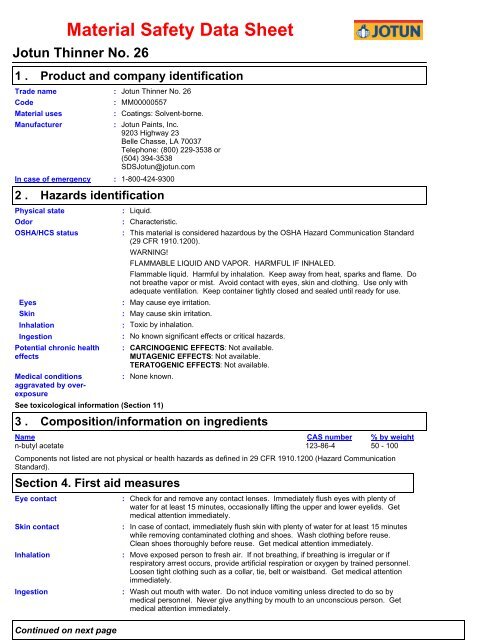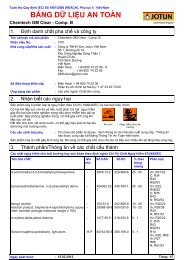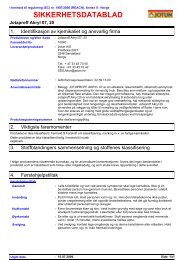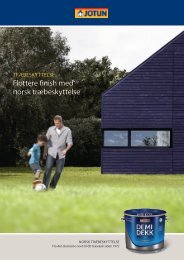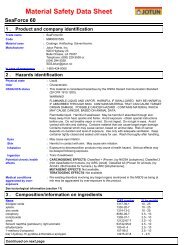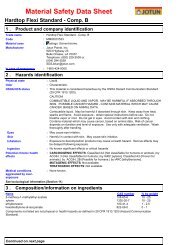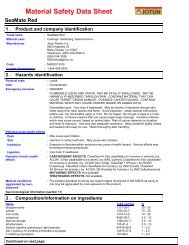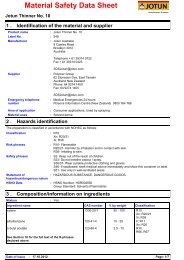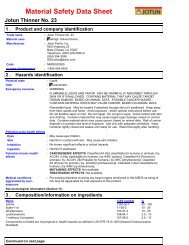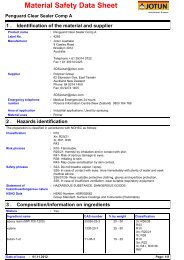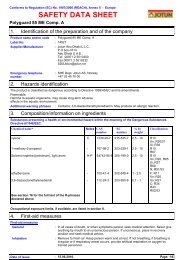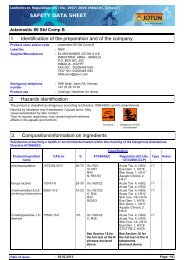SDS - Jotun Thinner No. 26 - Marine_Protective - English (us)
SDS - Jotun Thinner No. 26 - Marine_Protective - English (us)
SDS - Jotun Thinner No. 26 - Marine_Protective - English (us)
You also want an ePaper? Increase the reach of your titles
YUMPU automatically turns print PDFs into web optimized ePapers that Google loves.
Trade name<br />
Code<br />
Material <strong>us</strong>es<br />
Manufacturer<br />
In case of emergency<br />
Material Safety Data Sheet<br />
<strong>Jotun</strong> <strong>Thinner</strong> <strong>No</strong>. <strong>26</strong><br />
1 .<br />
2 .<br />
Physical state<br />
Eyes<br />
Skin<br />
Inhalation<br />
Ingestion<br />
Product and company identification<br />
: <strong>Jotun</strong> <strong>Thinner</strong> <strong>No</strong>. <strong>26</strong><br />
: MM00000557<br />
: Coatings: Solvent-borne.<br />
: <strong>Jotun</strong> Paints, Inc.<br />
9203 Highway 23<br />
Belle Chasse, LA 70037<br />
Telephone: (800) 229-3538 or<br />
(504) 394-3538<br />
<strong>SDS</strong><strong>Jotun</strong>@jotun.com<br />
:<br />
1-800-424-9300<br />
Hazards identification<br />
Odor<br />
OSHA/HCS stat<strong>us</strong><br />
Potential chronic health<br />
effects<br />
Medical conditions<br />
aggravated by overexposure<br />
See toxicological information (Section 11)<br />
3 .<br />
: Liquid.<br />
: Characteristic.<br />
: This material is considered hazardo<strong>us</strong> by the OSHA Hazard Communication Standard<br />
(29 CFR 1910.1200).<br />
WARNING!<br />
FLAMMABLE LIQUID AND VAPOR. HARMFUL IF INHALED.<br />
Flammable liquid. Harmful by inhalation. Keep away from heat, sparks and flame. Do<br />
not breathe vapor or mist. Avoid contact with eyes, skin and clothing. Use only with<br />
adequate ventilation. Keep container tightly closed and sealed until ready for <strong>us</strong>e.<br />
: May ca<strong>us</strong>e eye irritation.<br />
: May ca<strong>us</strong>e skin irritation.<br />
: Toxic by inhalation.<br />
: <strong>No</strong> known significant effects or critical hazards.<br />
: CARCINOGENIC EFFECTS: <strong>No</strong>t available.<br />
MUTAGENIC EFFECTS: <strong>No</strong>t available.<br />
TERATOGENIC EFFECTS: <strong>No</strong>t available.<br />
:<br />
<strong>No</strong>ne known.<br />
Composition/information on ingredients<br />
Name CAS number % by weight<br />
n-butyl acetate 123-86-4 50 - 100<br />
Components not listed are not physical or health hazards as defined in 29 CFR 1910.1200 (Hazard Communication<br />
Standard).<br />
Section 4. First aid measures<br />
Eye contact<br />
Skin contact<br />
Inhalation<br />
Ingestion<br />
Continued on next page<br />
:<br />
:<br />
:<br />
:<br />
Check for and remove any contact lenses. Immediately fl<strong>us</strong>h eyes with plenty of<br />
water for at least 15 minutes, occasionally lifting the upper and lower eyelids. Get<br />
medical attention immediately.<br />
In case of contact, immediately fl<strong>us</strong>h skin with plenty of water for at least 15 minutes<br />
while removing contaminated clothing and shoes. Wash clothing before re<strong>us</strong>e.<br />
Clean shoes thoroughly before re<strong>us</strong>e. Get medical attention immediately.<br />
Move exposed person to fresh air. If not breathing, if breathing is irregular or if<br />
respiratory arrest occurs, provide artificial respiration or oxygen by trained personnel.<br />
Loosen tight clothing such as a collar, tie, belt or waistband. Get medical attention<br />
immediately.<br />
Wash out mouth with water. Do not induce vomiting unless directed to do so by<br />
medical personnel. Never give anything by mouth to an unconscio<strong>us</strong> person. Get<br />
medical attention immediately.
<strong>Jotun</strong> <strong>Thinner</strong> <strong>No</strong>. <strong>26</strong> Page: 2/6<br />
Section 4. First aid measures<br />
Protection of first-aiders<br />
5 .<br />
Fire-fighting measures<br />
Special protective<br />
equipment for fire-fighters<br />
: <strong>No</strong> action shall be taken involving any personal risk or without suitable training. If it<br />
is s<strong>us</strong>pected that fumes are still present, the rescuer should wear an appropriate<br />
mask or self-contained breathing apparat<strong>us</strong>. It may be dangero<strong>us</strong> to the person<br />
providing aid to give mouth-to-mouth res<strong>us</strong>citation. Wash contaminated clothing<br />
thoroughly with water before removing it, or wear gloves.<br />
Flammability of the product<br />
Products of comb<strong>us</strong>tion<br />
Suitable<br />
:<br />
:<br />
:<br />
May be comb<strong>us</strong>tible at high temperature.<br />
Decomposition products may include the following materials:<br />
carbon dioxide<br />
carbon monoxide<br />
Use dry chemical, CO2, water spray (fog) or foam.<br />
<strong>No</strong>t suitable : Do not <strong>us</strong>e water jet.<br />
Special exposure hazards :<br />
:<br />
Section 6. Accidental release measures<br />
Personal precautions :<br />
Environmental precautions<br />
Methods for cleaning up :<br />
Section 7. Handling and storage<br />
Promptly isolate the scene by removing all persons from the vicinity of the incident if<br />
there is a fire. <strong>No</strong> action shall be taken involving any personal risk or without suitable<br />
training. Move containers from fire area if this can be done without risk. Use water<br />
spray to keep fire-exposed containers cool.<br />
Flammable liquid. In a fire or if heated, a pressure increase will occur and the container<br />
may burst, with the risk of a subsequent explosion. Runoff to sewer may create fire or<br />
explosion hazard.<br />
Fire-fighters should wear appropriate protective equipment and self-contained breathing<br />
apparat<strong>us</strong> (SCBA) with a full face-piece operated in positive pressure mode.<br />
<strong>No</strong> action shall be taken involving any personal risk or without suitable training.<br />
Evacuate surrounding areas. Keep unnecessary and unprotected personnel from<br />
entering. Do not touch or walk through spilled material. Shut off all ignition sources.<br />
<strong>No</strong> flares, smoking or flames in hazard area. Do not breathe vapor or mist. Provide<br />
adequate ventilation. Wear appropriate respirator when ventilation is inadequate.<br />
Put on appropriate personal protective equipment (see Section 8).<br />
: Avoid dispersal of spilled material and runoff and contact with soil, waterways, drains<br />
and sewers. Inform the relevant authorities if the product has ca<strong>us</strong>ed environmental<br />
pollution (sewers, waterways, soil or air).<br />
Stop leak if without risk. Move containers from spill area. Approach release from<br />
upwind. Prevent entry into sewers, water courses, basements or confined areas.<br />
Wash spillages into an effluent treatment plant or proceed as follows. Contain and<br />
collect spillage with non-comb<strong>us</strong>tible, absorbent material e.g. sand, earth, vermiculite<br />
or diatomaceo<strong>us</strong> earth and place in container for disposal according to local<br />
regulations (see section 13). Use spark-proof tools and explosion-proof equipment.<br />
Dispose of via a licensed waste disposal contractor. Contaminated absorbent<br />
material may pose the same hazard as the spilled product. <strong>No</strong>te: see section 1 for<br />
emergency contact information and section 13 for waste disposal.<br />
Handling :<br />
Put on appropriate personal protective equipment (see Section 8). Eating, drinking<br />
and smoking should be prohibited in areas where this material is handled, stored and<br />
processed. Workers should wash hands and face before eating, drinking and<br />
smoking. Remove contaminated clothing and protective equipment before entering<br />
eating areas. Do not get in eyes or on skin or clothing. Do not breathe vapor or<br />
mist. Do not ingest. Use only with adequate ventilation. Wear appropriate<br />
respirator when ventilation is inadequate. Do not enter storage areas and confined<br />
spaces unless adequately ventilated. Keep in the original container or an approved<br />
alternative made from a compatible material, kept tightly closed when not in <strong>us</strong>e.<br />
Store and <strong>us</strong>e away from heat, sparks, open flame or any other ignition source. Use<br />
explosion-proof electrical (ventilating, lighting and material handling) equipment.<br />
Use non-sparking tools. Take precautionary measures against electrostatic<br />
discharges. To avoid fire or explosion, dissipate static electricity during transfer by<br />
grounding and bonding containers and equipment before transferring material.<br />
Empty containers retain product residue and can be hazardo<strong>us</strong>. Do not re<strong>us</strong>e<br />
container.<br />
Continued on next page
<strong>Jotun</strong> <strong>Thinner</strong> <strong>No</strong>. <strong>26</strong> Page: 3/6<br />
Section 7. Handling and storage<br />
Storage :<br />
Store in accordance with local regulations. Store in a segregated and approved<br />
area. Store in original container protected from direct sunlight in a dry, cool and wellventilated<br />
area, away from incompatible materials (see section 10) and food and<br />
drink. Eliminate all ignition sources. Separate from oxidizing materials. Keep<br />
container tightly closed and sealed until ready for <strong>us</strong>e. Containers that have been<br />
opened m<strong>us</strong>t be carefully resealed and kept upright to prevent leakage. Do not store<br />
in unlabeled containers. Use appropriate containment to avoid environmental<br />
contamination.<br />
8 .<br />
Exposure controls/personal protection<br />
Product name<br />
Exposure limits<br />
n-butyl acetate ACGIH TLV (United States, 1/2009).<br />
STEL: 200 ppm 15 minute(s).<br />
TWA: 150 ppm 8 hour(s).<br />
NIOSH REL (United States, 6/2009).<br />
STEL: 950 mg/m³ 15 minute(s).<br />
STEL: 200 ppm 15 minute(s).<br />
TWA: 710 mg/m³ 10 hour(s).<br />
TWA: 150 ppm 10 hour(s).<br />
OSHA PEL (United States, 11/2006).<br />
TWA: 710 mg/m³ 8 hour(s).<br />
TWA: 150 ppm 8 hour(s).<br />
OSHA PEL 1989 (United States, 3/1989).<br />
STEL: 950 mg/m³ 15 minute(s).<br />
STEL: 200 ppm 15 minute(s).<br />
TWA: 710 mg/m³ 8 hour(s).<br />
TWA: 150 ppm 8 hour(s).<br />
Engineering measures<br />
Eyes<br />
Skin<br />
Respiratory<br />
Hands :<br />
Hygiene measures<br />
: Use only with adequate ventilation. Use process enclosures, local exha<strong>us</strong>t ventilation or<br />
other engineering controls to keep worker exposure to airborne contaminants below any<br />
recommended or statutory limits. The engineering controls also need to keep gas, vapor<br />
or d<strong>us</strong>t concentrations below any lower explosive limits. Use explosion-proof ventilation<br />
equipment.<br />
: Safety eyewear complying with an approved standard should be <strong>us</strong>ed when a risk<br />
assessment indicates this is necessary to avoid exposure to liquid splashes, mists or<br />
d<strong>us</strong>ts.<br />
: Personal protective equipment for the body should be selected based on the task being<br />
performed and the risks involved and should be approved by a specialist before handling<br />
this product.<br />
: Use a properly fitted, air-purifying or air-fed respirator complying with an approved<br />
standard if a risk assessment indicates this is necessary. Respirator selection m<strong>us</strong>t be<br />
based on known or anticipated exposure levels, the hazards of the product and the safe<br />
working limits of the selected respirator.<br />
Chemical-resistant, impervio<strong>us</strong> gloves complying with an approved standard should be<br />
worn at all times when handling chemical products if a risk assessment indicates this is<br />
necessary.<br />
: Wash hands, forearms and face thoroughly after handling chemical products, before<br />
eating, smoking and <strong>us</strong>ing the lavatory and at the end of the working period. Appropriate<br />
techniques should be <strong>us</strong>ed to remove potentially contaminated clothing. Wash<br />
contaminated clothing before re<strong>us</strong>ing. Ensure that eyewash stations and safety showers<br />
are close to the workstation location.<br />
9 .<br />
Physical and chemical properties<br />
Physical state<br />
Flash point<br />
Color<br />
Odor<br />
Relative density<br />
VOC<br />
: Liquid.<br />
: Closed cup: 27°C (80,6°F)<br />
: Clear.<br />
: Characteristic.<br />
: 0.88 g/cm 3<br />
:<br />
7.34 pounds/gallon<br />
880 % (w/w)<br />
Continued on next page
<strong>Jotun</strong> <strong>Thinner</strong> <strong>No</strong>. <strong>26</strong> Page: 4/6<br />
9 .<br />
Physical and chemical properties<br />
Solubility :<br />
Section 10. Stability and reactivity<br />
Stability and reactivity<br />
Hazardo<strong>us</strong> decomposition<br />
products<br />
Hazardo<strong>us</strong> polymerization<br />
:<br />
:<br />
:<br />
Insoluble in the following materials: cold water and hot water.<br />
The product is stable.<br />
Section 11. Toxicological information<br />
Other toxic effects on<br />
humans<br />
Specific effects<br />
Carcinogenic effects<br />
Mutagenic effects<br />
Reproduction toxicity<br />
Chronic effects<br />
12 .<br />
Ecological information<br />
Ecotoxicity data<br />
Product/ingredient name<br />
n-butyl acetate<br />
Environmental precautions<br />
Products of degradation<br />
13 .<br />
Disposal considerations<br />
Waste disposal<br />
:<br />
:<br />
:<br />
:<br />
:<br />
Under normal conditions of storage and <strong>us</strong>e, hazardo<strong>us</strong> decomposition products<br />
should not be produced.<br />
Under normal conditions of storage and <strong>us</strong>e, hazardo<strong>us</strong> polymerization will not<br />
occur.<br />
Exposure to component solvent vapor concentrations in excess of the stated<br />
occupational exposure limit may result in adverse health effects such as muco<strong>us</strong><br />
membrane and respiratory system irritation and adverse effects on the kidneys, liver<br />
and central nervo<strong>us</strong> system. Solvents may ca<strong>us</strong>e some of the above effects by<br />
absorption through the skin. Symptoms and signs include headache, dizziness,<br />
fatigue, m<strong>us</strong>cular weakness, drowsiness and, in extreme cases, loss of<br />
conscio<strong>us</strong>ness. Repeated or prolonged contact with the preparation may ca<strong>us</strong>e<br />
removal of natural fat from the skin, resulting in non-allergic contact dermatitis and<br />
absorption through the skin. If splashed in the eyes, the liquid may ca<strong>us</strong>e irritation<br />
and reversible damage. Swallowing may ca<strong>us</strong>e na<strong>us</strong>ea, diarrhea, vomiting, gastrointestinal<br />
irritation and chemical pneumonia.<br />
<strong>No</strong> known significant effects or critical hazards.<br />
<strong>No</strong> known significant effects or critical hazards.<br />
<strong>No</strong> known significant effects or critical hazards.<br />
<strong>No</strong> known significant effects or critical hazards.<br />
Species Period Result<br />
Pimephales promelas (EC50) 48 hour(s)<br />
19 mg/l<br />
Pimephales promelas (LC50) 96 hour(s)<br />
18 mg/l<br />
Lepomis macrochir<strong>us</strong> (LC50) 96 hour(s)<br />
100 mg/l<br />
: <strong>No</strong> known significant effects or critical hazards.<br />
: Products of degradation: carbon oxides (CO, CO2) and water.<br />
:<br />
The generation of waste should be avoided or minimized wherever possible. Significant<br />
quantities of waste product residues should not be disposed of via the foul sewer but<br />
processed in a suitable effluent treatment plant. Dispose of surpl<strong>us</strong> and non-recyclable<br />
products via a licensed waste disposal contractor. Disposal of this product, solutions<br />
and any by-products should at all times comply with the requirements of environmental<br />
protection and waste disposal legislation and any regional local authority requirements.<br />
Waste packaging should be recycled. Incineration or landfill should only be considered<br />
when recycling is not feasible. This material and its container m<strong>us</strong>t be disposed of in a<br />
safe way. Care should be taken when handling emptied containers that have not been<br />
cleaned or rinsed out. Empty containers or liners may retain some product residues.<br />
Vapor from product residues may create a highly flammable or explosive atmosphere<br />
inside the container. Do not cut, weld or grind <strong>us</strong>ed containers unless they have been<br />
cleaned thoroughly internally. Avoid dispersal of spilled material and runoff and contact<br />
with soil, waterways, drains and sewers.<br />
Disposal should be in accordance with applicable regional, national and local laws and regulations. Local<br />
regulations may be more stringent than regional or national requirements.<br />
The information presented below only applies to the material as supplied. The identification based on<br />
characteristic(s) or listing may not apply if the material has been <strong>us</strong>ed or otherwise contaminated. It is the<br />
responsibility of the waste generator to determine the toxicity and physical properties of the material generated to<br />
determine the proper waste identification and disposal methods in compliance with applicable regulations.<br />
Continued on next page
<strong>Jotun</strong> <strong>Thinner</strong> <strong>No</strong>. <strong>26</strong> Page: 5/6<br />
13 .<br />
Disposal considerations<br />
Refer to Section 7: HANDLING AND STORAGE and Section 8: EXPOSURE CONTROLS/PERSONAL PROTECTION<br />
for additional handling information and protection of employees.<br />
Section 14. Transport information<br />
Regulatory<br />
information<br />
UN number<br />
Proper shipping<br />
name<br />
Class PG* Label Additional<br />
information<br />
DOT Classification<br />
1123<br />
BUTYL ACETATES<br />
3 III<br />
-<br />
TDG Classification 1123 BUTYL ACETATES 3 III<br />
-<br />
ADR/RID Class 1123 BUTYL ACETATES 3 III<br />
IMDG Class 1123 BUTYL ACETATES 3 III<br />
Tunnel restriction<br />
code: (D/E)<br />
Hazard identification<br />
number: 30<br />
Emergency schedules<br />
(EmS): F-E, S-D<br />
<strong>Marine</strong> pollutant: <strong>No</strong>.<br />
IATA-DGR Class 1123 BUTYL ACETATES 3<br />
III<br />
-<br />
PG* : Packing group<br />
-<br />
15 .<br />
Regulatory information<br />
HCS Classification<br />
U.S. Federal regulations<br />
:<br />
:<br />
Flammable liquid<br />
Toxic material<br />
TSCA 8(a) IUR Exempt/Partial exemption: <strong>No</strong>t determined<br />
United States inventory (TSCA 8b): All components are listed or exempted.<br />
SARA 302/304/311/312 extremely hazardo<strong>us</strong> substances: <strong>No</strong> products were found.<br />
SARA 302/304 emergency planning and notification: <strong>No</strong> products were found.<br />
SARA 302/304/311/312 hazardo<strong>us</strong> chemicals: n-butyl acetate<br />
SARA 311/312 M<strong>SDS</strong> distribution - chemical inventory - hazard identification: n-<br />
butyl acetate: Fire hazard, Immediate (acute) health hazard, Delayed (chronic) health<br />
hazard<br />
Clean Air Act (CAA) 112 accidental release prevention: <strong>No</strong> products were found.<br />
State regulations<br />
Continued on next page<br />
:<br />
Connecticut Carcinogen Reporting: <strong>No</strong>ne of the components are listed.<br />
Connecticut Hazardo<strong>us</strong> Material Survey: <strong>No</strong>ne of the components are listed.<br />
Florida substances: <strong>No</strong>ne of the components are listed.<br />
Illinois Chemical Safety Act: <strong>No</strong>ne of the components are listed.<br />
Illinois Toxic Substances Disclosure to Employee Act: <strong>No</strong>ne of the components are<br />
listed.<br />
Louisiana Reporting: <strong>No</strong>ne of the components are listed.<br />
Louisiana Spill: <strong>No</strong>ne of the components are listed.<br />
Massach<strong>us</strong>etts Spill: <strong>No</strong>ne of the components are listed.<br />
Massach<strong>us</strong>etts Substances: The following components are listed: n-butyl acetate<br />
Michigan Critical Material: <strong>No</strong>ne of the components are listed.<br />
Minnesota Hazardo<strong>us</strong> Substances: <strong>No</strong>ne of the components are listed.<br />
New Jersey Hazardo<strong>us</strong> Substances: The following components are listed: n-butyl<br />
acetate<br />
New Jersey Spill: <strong>No</strong>ne of the components are listed.
<strong>Jotun</strong> <strong>Thinner</strong> <strong>No</strong>. <strong>26</strong> Page: 6/6<br />
15 .<br />
Regulatory information<br />
New Jersey Toxic Catastrophe Prevention Act: <strong>No</strong>ne of the components are listed.<br />
New York Acutely Hazardo<strong>us</strong> Substances: The following components are listed: Butyl<br />
acetate<br />
New York Toxic Chemical Release Reporting: <strong>No</strong>ne of the components are listed.<br />
Pennsylvania RTK Hazardo<strong>us</strong> Substances: The following components are listed: n-<br />
butyl acetate<br />
Rhode Island Hazardo<strong>us</strong> Substances: <strong>No</strong>ne of the components are listed.<br />
EU regulations<br />
Risk phrases<br />
Safety phrases<br />
16 .<br />
Other information<br />
Label requirements :<br />
Hazardo<strong>us</strong> Material<br />
Information System (U.S.A.)<br />
:<br />
:<br />
:<br />
R10- Flammable.<br />
R66- Repeated exposure may ca<strong>us</strong>e skin dryness or cracking.<br />
R67- Vapors may ca<strong>us</strong>e drowsiness and dizziness.<br />
S23- Do not breathe vapor / spray.<br />
S38- In case of insufficient ventilation, wear suitable respiratory equipment.<br />
FLAMMABLE LIQUID AND VAPOR. HARMFUL IF INHALED.<br />
Health<br />
0<br />
Flammability<br />
0<br />
Physical hazards 0<br />
PERSONAL PROTECTION<br />
National Fire Protection<br />
Association (U.S.A.)<br />
:<br />
Health<br />
2<br />
3<br />
0<br />
Flammability<br />
Instability<br />
Special<br />
Date of issue<br />
Version<br />
<strong>No</strong>tice to reader<br />
:<br />
:<br />
19.06.2012.<br />
1<br />
To the best of our knowledge, the information contained herein is accurate. However, neither the above-named<br />
supplier, nor any of its subsidiaries, assumes any liability whatsoever for the accuracy or completeness of the<br />
information contained herein.<br />
Final determination of suitability of any material is the sole responsibility of the <strong>us</strong>er. All materials may present<br />
unknown hazards and should be <strong>us</strong>ed with caution. Although certain hazards are described herein, we cannot<br />
guarantee that these are the only hazards that exist.<br />
Indicates information that has changed from previo<strong>us</strong>ly issued version.


